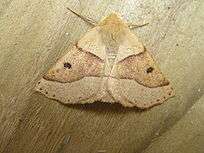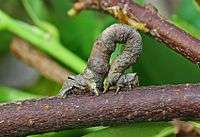Scalloped oak
| Scalloped oak | |
|---|---|
 | |
| Scientific classification | |
| Kingdom: | Animalia |
| Phylum: | Arthropoda |
| Class: | Insecta |
| Order: | Lepidoptera |
| Family: | Geometridae |
| Genus: | Crocallis |
| Species: | C. elinguaria |
| Binomial name | |
| Crocallis elinguaria Linnaeus, 1758 | |
The scalloped oak (Crocallis elinguaria) is a moth of the family Geometridae. It is a common European species.

This is a distinctive species, usually with yellow forewings with a broad orange-brown band and a pointed apex. There can be considerable variation, with the central band sometimes the same colour as the rest of the forewing, ranging from pale yellow to orange-brown. Melanic forms are also known. There is always a blackish discal spot on the forewing. The hindwings are plain whitish. The wingspan is 40–46 mm. The adults fly at night in July and August and are attracted to light, sometimes in large numbers.
The larva, grey and twig-like, feeds on various trees and shrubs (see list below) and is omnivorous and cannibalistic feeding also on smaller larvae. The species overwinters as an egg.
- ^ The flight season refers to the British Isles. This may vary in other parts of the range.
Recorded food plants
- Alnus - Alder
- Betula - Birch
- Calluna - Heather
- Corylus - Common hazel
- Lonicera - Honeysuckle
- Populus - Aspen
- Prunus - Bird cherry
- Rhamnus - Buckthorn
- Ribes - Currant
- Rosa - Rose
- Rubus - Raspberry
- Salix - Willow
- Sorbus - Rowan
- Syringa - Common lilac
- Tilia - Lime
- Vaccinium
References
- Chinery, Michael Collins Guide to the Insects of Britain and Western Europe 1986 (Reprinted 1991)
- Skinner, Bernard Colour Identification Guide to Moths of the British Isles 1984